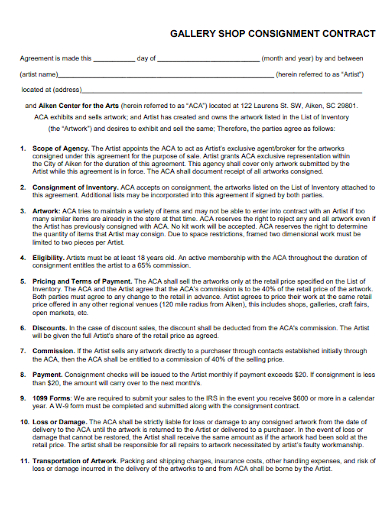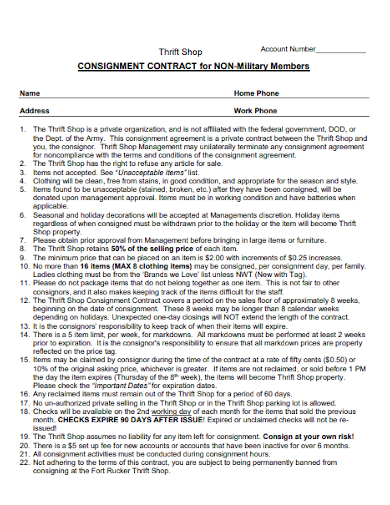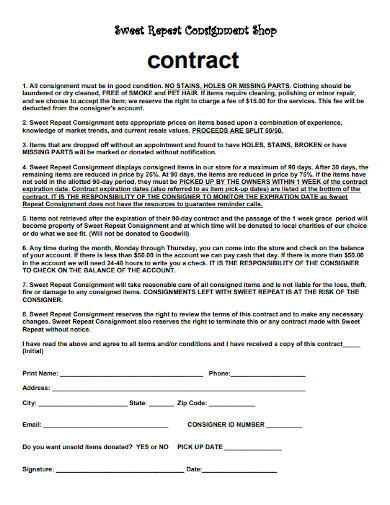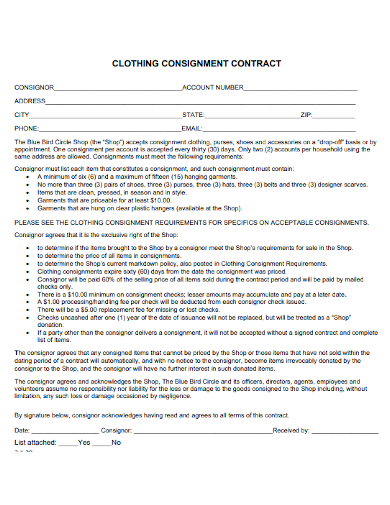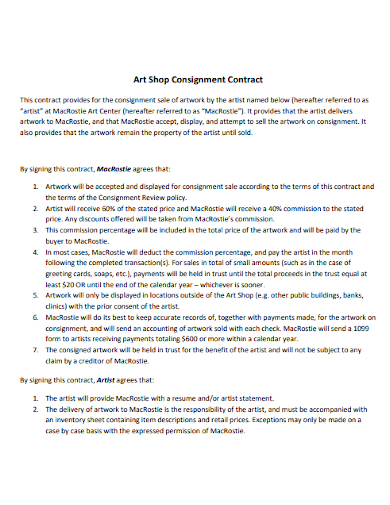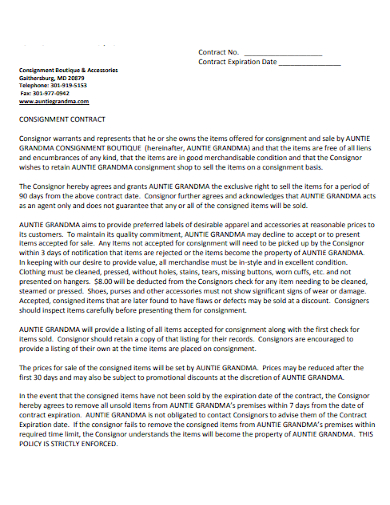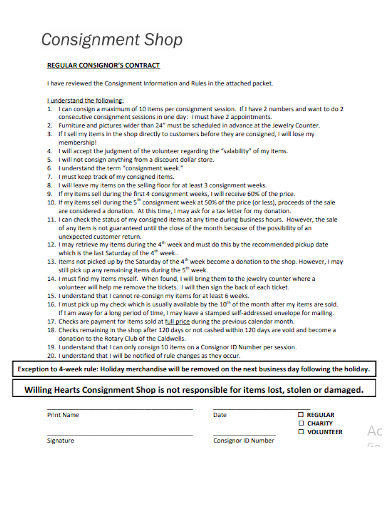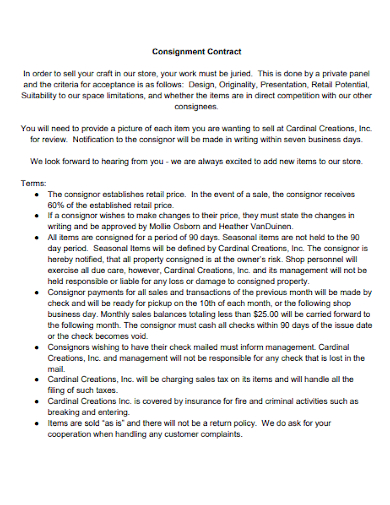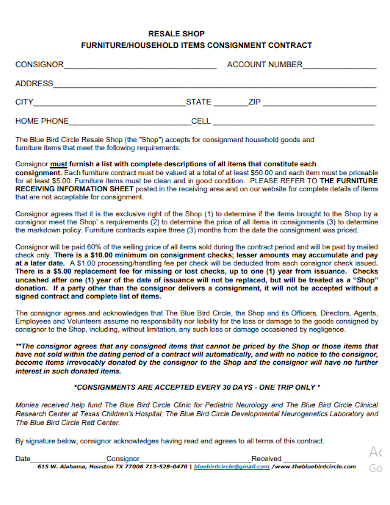A consignment shop sells used merchandise at prices lower than most retail shops. The income from this type of store is divided between the consignee, who serves as the store owner, and the consignor, who provides the merchandise. If you’re planning to open your consignment shop, you must know how this type of business works. You must also know how to people who can provide the merchandise to provide you the merchandise that you will use to sell in your shop. If you’ve found those people, remember that you are conducting business with them and the first step is to create a contract that signifies you and the other party is engaged in a consignment business. If you don’t know how to make a consignment contract, this article will guide you on how to make one.
10+ Shop Consignment Contract Samples
1. Shop Consignment Contract Template
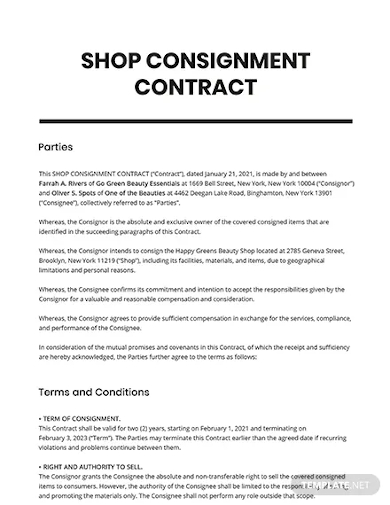
2. Gallery Shop Consignment Contract
3. Thrift Shop Consignment Contract
4. Sample Shop Consignment Contract
5. Clothing Shop Consignment Contract
6. Art Shop Consignment Contract
7. Consignment Boutique & Accessories Shop Contract
8. Regular Consignors Consignment Shop Contract
9. Craft Shop Consignment Contract
10. Furniture & Household Resale Shop Consignment Contract
11. First Call Resale Shop Consignment Contract
What is a Consignment Shop Contract?
A consignment shop contract, also known as a consignment inventory agreement or consignment sales agreement, is legal agreements document in which one party such as the consignor, gives the legal rights to another party, who is the consignee, to sell their merchandise on the consignor’s behalf.
Details to Include in a Shop Consignment Contract
1. Information of Both Parties
The first section of the contract must identify every party involved. The information that must be found here are:
- Consignee’s name, address of their store, and contact information
- Consignor’s name, personal address, and contact information
2. Merchandise Details
This section must declare all important details regarding the merchandise to be sold and the conditions and types that are admissable enough to sell. Also, state what quality control guidelines will be used to inspect the overall quality of the merchandise.
3. Pricing
This section should establish that the consignee will set its pricing based on the merchandise it gets. To be specific, you must describe how the pricing will be calculated by considering the following attributes of the merchandise such as its age, brand, condition, market demand, and style.
4. Consignment Terms
This part of the contract should discuss the period in which the consignee will sell the merchandise. You will also state how the consignee will make the pricing arrangements and strategically schedule marking down the remaining merchandise that wasn’t sold.
5. Payment Structure
Identify the accurate percentage of commission that the consignee will receive based on the sale of merchandise. It’s up to your agreement on how you will split the commission. Will you evenly split it? Will you retain 70% of the sales revenue and pay the consignee the remaining 30%?
6. Expenses and Ownership
This section must state what types of expenses is the consignee is responsible to pay for such as if there are any lost or damaged items, the consignee is assigned to pay for them while those items are in their possession.
7. Insurance
This section must point out any insurance details regarding the consigned merchandise. For example, the consignee is the one responsible to carry out the insurance of the consigned item.
8. Termination of the Contract
This section must discuss how the contract can be terminated. Describe the situations or events that will void the contract.
9. Signature Lines
Conclude the contract by including signature lines where both parties can sign the contract with the date which signifies that the contract is legally binding and all provisions and terms discusses and agreed upon will officially take into effect.
FAQs
What are the types of consignment arrangements?
The different types of consignment arrangements are exclusive and nonexclusive. If the consignment is exclusive, the consignee is the only person who has the right to sell the consignor’s goods. If the arrangement is nonexclusive, other consignees are also selling the same goods.
What are examples of consignment merchandise?
Some examples of consignment merchandise include apparel goods, household products, and automobiles.
What is a typical consignment fee?
The consignment fees may depend on the seller and the items being sold but generally, the seller will give 25% to 60% of the sales price as the consignment fee.
How is consignment pricing calculated?
Consignment pricing has a rule of thumb to calculate the price of the item at 25-40% of what the consignor originally paid for the item. However, the brand and condition of them should also be considered.
Once you’re done writing the contract make sure to review for any grammatical and spelling errors before you finalize it and print it out for signature. Discuss the details first with your consignee before you reach an agreement and officialize it by signing the contract. To help you get started making the contract, download our free sample templates above to use as your guide!
Related Posts
Sample Excuse Letter for School
Feature Writing Samples
FREE 10+ Security Guard Contract Samples in PDF | MS Word
FREE 10+ Option to Purchase Agreement Samples in MS Word | Apple Pages | PDF
FREE 26+ Curriculum Form Samples in MS Word | PDF
FREE 20+ Cleaning Service Proposal Samples in PDF | MS Word
FREE 29+ Sample Loan Application Form Templates in MS Word | PDF
FREE 10+ Event Venue Contract Samples in PDF | MS Word | Pages | Google Docs
FREE 10+ SBAR Samples in PDF | DOC
FREE 12+ Music Band Contract Templates in PDF | MS Word
FREE 10+ HVAC Maintenance Contract Samples in PDF | MS Word
FREE 10+ Social Media Marketing Contract Samples in MS Word | PDF
FREE 10+ Wholesale Assignment Contract Samples in PDF
FREE 18+ Financial Proposal Samples in PDF | MS Word | Google Docs | Pages
FREE 10+ Feasibility Study Samples in PDF

